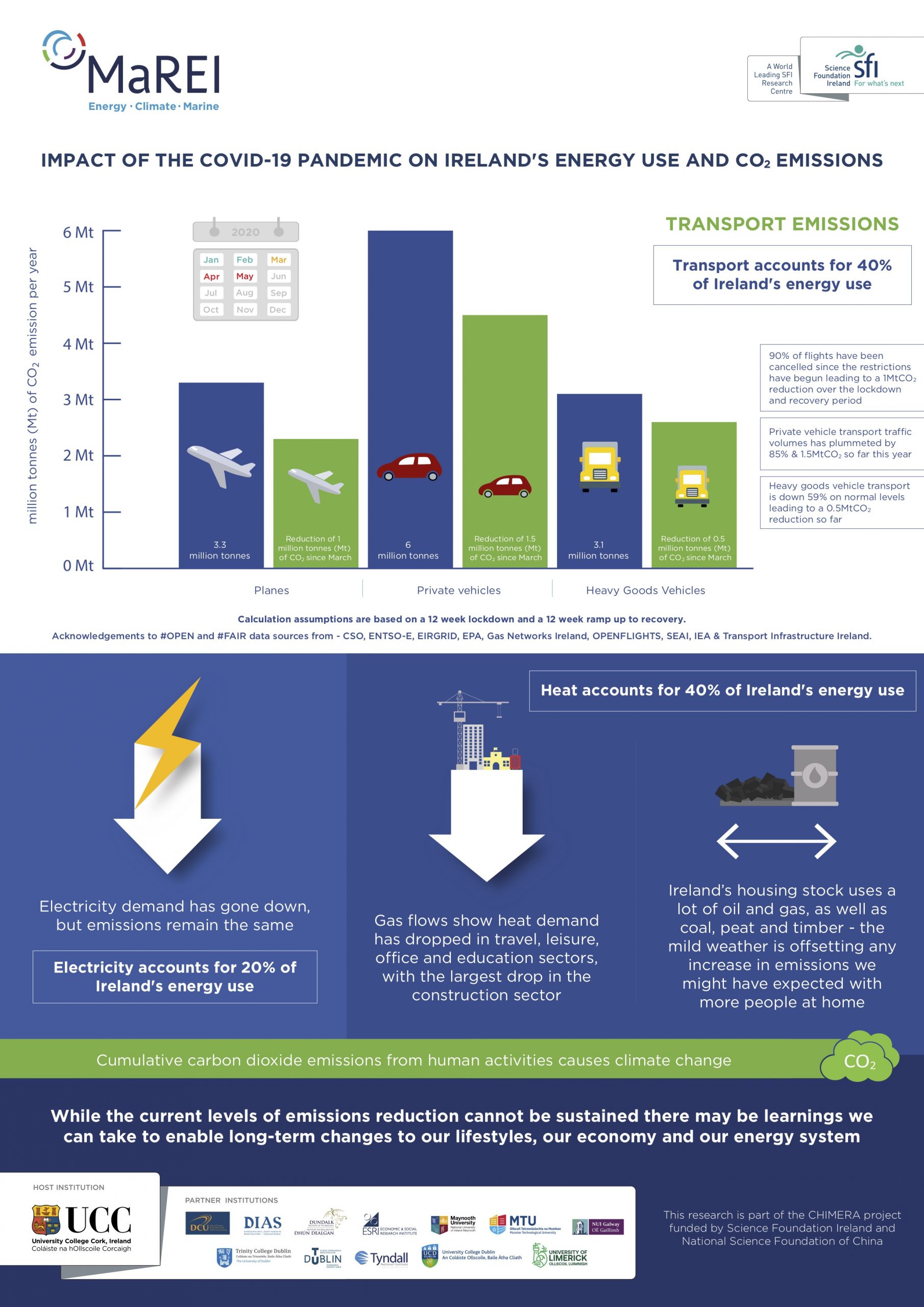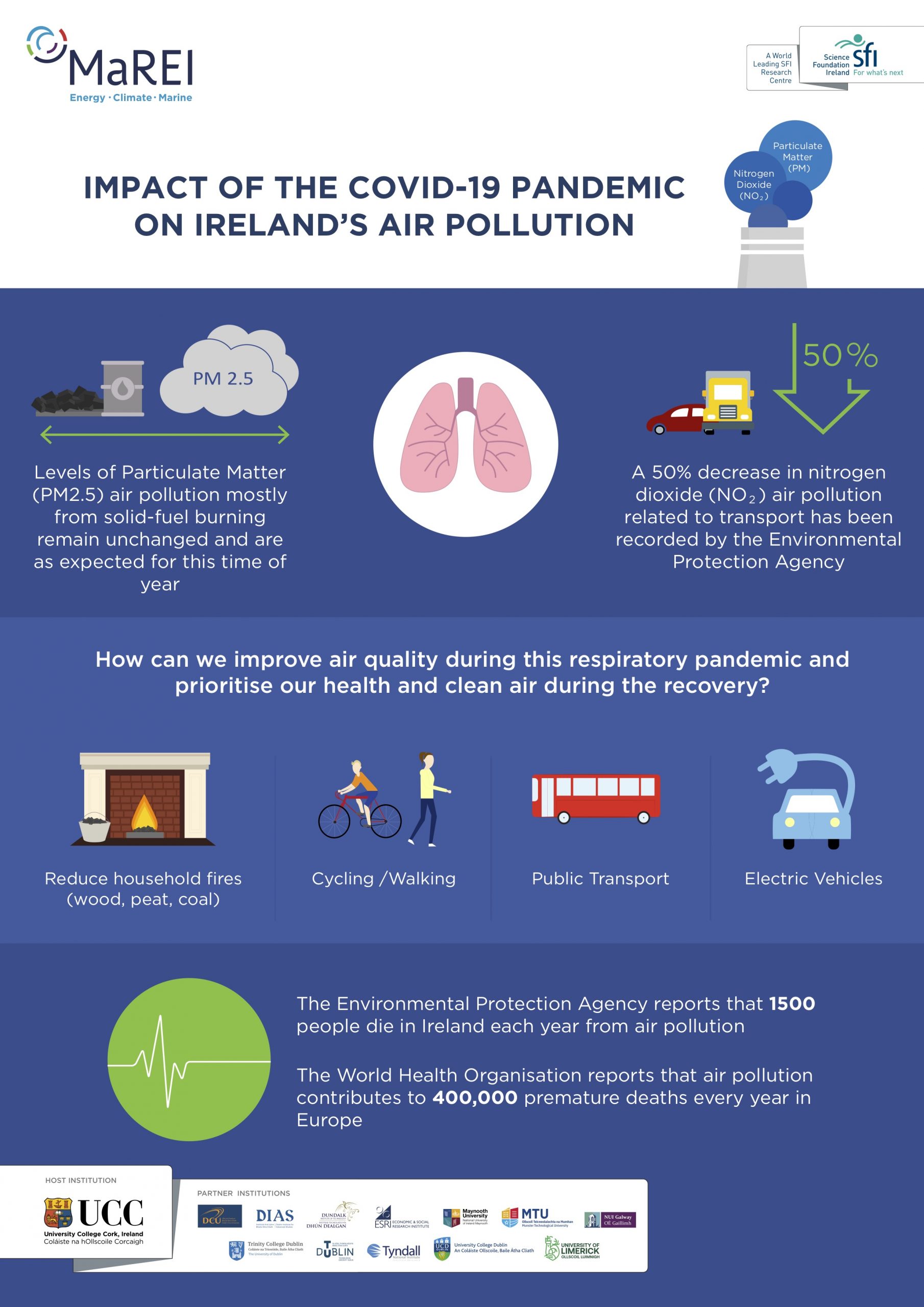
First full picture of Covid-19 restrictions on Ireland’s pollution levels revealed
Researchers at MaREI, the SFI Research Centre in Energy, Climate and Marine at University College Cork and NUI Galway reveal today the first full picture of the impact of Covid-19 restrictions on Ireland’s energy related pollution levels.
Report: The pandemic & Ireland’s Energy System
#CoronavirusIreland: As Ireland starts #Phase1 of reopening, new research suggests the decline in business activity has had a positive impact on the environment@NewsChambers has the details⤵️#VMNews | #COVID19 | #COVID_19 | #Coronavirus | @james_glynn pic.twitter.com/YgMF8DXhbr
— Virgin Media News (@VirginMediaNews) May 19, 2020
Since Covid-19 restrictions came into force the use of planes, trains and automobiles have all seen a dramatic fall and this snapshot illustrates exactly what impact these restrictions on movement across the nation are having on Ireland’s pollution levels.
The analysis examines Ireland’s pollution levels prior to lockdown measures and compares it with those levels during lockdown, among the findings is that pollution from cars has dropped by 50%, but air pollution from solid fuel burning has not changed. The analysis also shows that for every week we are in lockdown, Irish people will reclaim 5 hours that would have otherwise been spent stuck in their car. 9 out of 10 flights have been cancelled since restrictions commenced and if flight restrictions continue, it would be the equivalent of switching off Moneypoint coal fired power station for 6 months, the research shows. Meanwhile at home across Ireland, the research illustrates that every day is the weekend, as our electricity usage pattern now replicates a weekend demand profile 7 days a week.
Coronavirus: Lockdown leads to 50% drop in car pollution https://t.co/6F4FoygkfE
— The Irish Times (@IrishTimes) May 19, 2020
The analysis – The Pandemic and Ireland’s Energy System – what are the impacts for greenhouse gas emissions? – examines Ireland’s use of transport, heat, and electricity to show air pollution levels. The analysis shows the following;
TRANSPORT – sizeable reduction in activity

The energy we use for transport accounts for about 40% of Ireland’s energy consumption. Carbon dioxide emissions from private cars are nearly twice the amount of flights. Travelling to work and school accounts for over a third of the journeys taken by Irish people each year. For example, each week the school run requires Irish parents to drive a staggering 7 million kilometres, emitting an estimated of 1.2 ktCO2 (1200 tonnes) of CO2 emissions. That is equivalent to the annual driving of about 400 cars. In Ireland, flights are responsible for 3.3 million tonnes (Mt) of CO2 emission every year, which is the equivalent of 1 car driving 363,000 laps of the planet. 90% of rail energy service demand in Ireland is met by oil, the remaining by electricity
The analysis today shows the impact of Covid-19 restrictions across Ireland’s transport sector:
The #COVID19ireland lockdown continues to show workplace occupancy down 40%, retail down 90% and residential occupancy up 30% on February2020 baseline levels. @MaREIcentre @UCC @JerryDMurphy66 @BOGallachoir @osheaucc @osm_ie @tableau @googlemaps @Android @LeoVaradkar pic.twitter.com/v2p2pzanPt
— James Glynn (@james_glynn) May 19, 2020
Planes
- Nearly 9 out of 10 flights have been cancelled since the restrictions have begun, while the remainder are flying with low occupancy or to carry goods.
- Assuming flight restrictions last for 12 weeks, and that there will be another 12 weeks with partial recovery, this could result in a reduction of 1 MtCO2 of heat trapping gases this year. This would be the equivalent of switching off Moneypoint coal fired power station for 6 months.
- Given the difficulties the airlines are likely to face with continued social distancing impacting upon tourism, the final annual reduction in CO2 emissions from aviation may be considerably higher.
Trains
- DART and Intercity services are now operating at between 45% – 65% of their normal levels
- Providing a 12 week scenario for a restricted schedule, operating at 55% service, a carbon reduction of 22,000 tonnes of CO2 may be realised.
Automobiles (See animation at link below)
- Private car activity levels have dropped by more than 85% since the lockdown began.
- Based on 12 weeks of restrictions and another 12 weeks with partial measures, there could be a reduction of 1.5 MtCO2 from the travel restrictions from the private car fleet.
- In Ireland, the average commuter spends 28.2 minutes driving to work, so roughly 1 hour per day there and back. That means for every week we are in lockdown people will reclaim 5 hours that would have otherwise been spent stuck in their car.
- New car sales in March were 33% lower than March 2019 and in April car sales were down by 90% compared to April 2019. Sales of new EVs briefly bucked the downward trend in March when they increased by 41%. However in April EV sales re-aligned with national trends when sales decreased by 67%.
HEAT – Construction sector getting ready to back to work
Ireland’s housing stock uses a lot of oil and gas for heating, as well as solid fuels such as peat, coal and timber. Peat, coal and timber are also among the main sources of hazardous local air pollution in Ireland.
The analysis today shows:
- Heat demand has dropped in travel, leisure, office and education sector uses, the largest drop in gas demand being in the construction sector.
- There is a difference of 127GWh in gas flows compared to 2019 (excluding power sector gas demand) levels from week 10 to now. This equates approximately to a reduction of 63ktCO2 over the past 10 weeks. This is equivalent drop in the usage of gas of 25% of all gas central heated houses.
- The education & office sector gas consumption has not dropped to zero as one might expect while the buildings are at low occupancy levels now – as universities and combined heat and power plants consume the majority of this gas demand.
- The construction sector has picked up heat consumption in producing materials in the last few days in anticipation of the sector restarting back to work.
ELECTRICITY – Everyday is the weekend
During this time of significant remote virtual working, electricity has become our primary source of energy aiding in executing office work, lighting and entertainment.
The analysis today shows:
- The demand for electricity has seen a decrease of between 5-10% over seasonal expectations since early March as a result of the COVID-19 measures.
- Everyday is the weekend as the generation profile now replicates a weekend demand profile 7 days a week. Sources for the supply of electricity in Ireland include fossil fuels (gas, coal and oil), renewables (wind, solar, biogas and hydro), electricity imported from Great Britain and other sources such as peat. The mix of fuels that is being used depends on the weather, how much electricity is available from renewable sources as well as at what price other producers are willing to generate electricity.
AIR POLLUTION – solid fuel pollutants have seen no drop

The World Health Organisation estimates annual deaths of 1,500 per year are attributable to outdoor air pollution in Ireland. Data from the European Environment Agency’s (EEA) has shown how concentrations of nitrogen dioxide (NO2) — a pollutant mainly emitted by road transport and to a lesser extent electricity generation — have decreased in many European cities. NO2 has been linked to increased levels of lung conditions ranging from asthma and bronchitis to respiratory-related hospital admissions and emergency room visits. There are many different types and sources of air pollution in Ireland, including fine particulate matter (PM2.5) which refers to tiny particles produced mainly from solid fuel burning (Peat, Coal and Timber). PM2.5 is linked to increased incidence of respiratory and cardiovascular disease and higher death rates.
Today’s analysis shows
- The EPA have reported a decrease in concentrations of up to 50% of nitrogen dioxide at many monitoring stations across the National Air Quality Monitoring Network.
- The EPA Ireland have stated that currently, levels of air pollution in Ireland resulting from solid-fuel burning have not changed due to Covid-19 restrictions and are generally as expected for this time of year.
Lessons learned
“Covid-19 Lockdown measures across the globe are creating a natural experiment for climate and energy researchers to observe how extreme demand scenarios can drive large scale fossil fuel demand destruction and collapse oil market prices. By exploring the impact these restrictions are having on Ireland’s pollution levels, we are also seeking to understand feasible actions to mitigate climate change” commented one of the UCC based researchers, Dr James Glynn.
“We need to make long-term, equitable and sustainable changes to our lifestyles, to our economy and to our energy system” commented Dr Glynn. “Climate change mitigation is a marathon event requiring rapid and sustained steady changes in how we consume energy.”
View downloadable animation of vehicle count in Ireland pre and post lockdown here
Report: The pandemic & Ireland’s Energy System
MEDIA SNIPPETS
RTE Drivetime: https://twitter.com/boucherhayes/status/1262827426708586497?s=20
Silicon Republic: https://www.siliconrepublic.com/innovation/covid-19-pollution-levels-ireland-marei
The Journal: https://www.thejournal.ie/transport-pollution-5102932-May2020/
96FM radio: https://play.acast.com/s/corks-96-fm-opinion-line/6d7a7fad-2171-4ed7-8f9c-c5f0006cb288 (start at 1hr:43min)
Tipp Mid West Radio Call with Joe Pryce: https://www.tippmidwestradio.com/schedule/#thu
RTÉ from O’Riordan and Dr Hannah Daly: Analysis: the massive reduction in traffic and emissions will not necessarily help Ireland meet its climate change targets
RTÉ Brainstorm from Siddharth Joshi: Analysis: electricity demand in Ireland has fallen, but electricity-related greenhouse gas emissions have increased
Tableau From Dr James Glynn: Tracking the changing trends in the Irish power system during the Covid-19 lockdown


